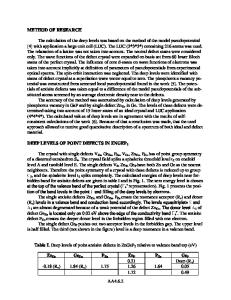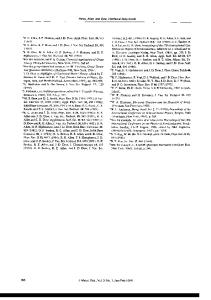Deep Levels in Superlattices
- PDF / 792,879 Bytes
- 12 Pages / 420.48 x 639 pts Page_size
- 79 Downloads / 392 Views
DEEP LEVELS IN SUPERLATTICES
JOHN D. DOW, SHANG YUAN REN, JUN SHEN, AND MIN-HSIUNG TSAI Department of Physics, University of Notre Dame, Notre Dame, Indiana 46556 U.S.A. ABSTRACT The physics of deep levels in semiconductors is reviewed, with emphasis on the fact that all substitutional impurities produce deep levels - some of which may not lie within the fundamental band gap. The character of a dopant changes when one of the deep levels moves into or out of the fundamental gap in response to a perturbation such as pressure or change of host composition. For example, Si on a Ga site in GaAs is a shallow donor, but becomes a deep trap for x>O.3 in AexGalixAs. Such shallow-deep transitions can be induced in superlattices by changing the period-widths and quantum confinement. A good rule of thumb for deep levels in superlattices is that the energy levels with respect to vacuum are relatively insensitive (on a >0.1 eV scale) to superlattice period-widths, but that the band edges of the superlattices are sensitive to changes of period. Hence the deep level positions relative to the band edges are sensitive to the period-widths, and shallow-deep transitions can be induced by band-gap engineering the superlattice periods.
DOPING AND DEEP LEVELS IN BULK SEMICONDUCTORS In recent years, the theory of doping has been revised from the old effective-mass theory [1] which explained the behavior of substitutional P in Si and Se on an As site (SeAs) in GaAs so well. In the effective-mass model, one simply assumed that an impurity such as Se substituting for As would have a singly-ionized stable ground state Se+ were it not for the long-ranged screened Coulomb potential -e 2 /er which binds the "extra" electron of Se in a hydrogenic shallow-donor orbital with radius a.'t 2 e/m*e2 much larger .
than a typical lattice constant. (Here m is the effective mass of the electron, a is the dielectric constant of the host, and we have, for simplicity of presentation, overlooked the anisotropy of m*.) Hydrogenic effective-mass theory has a significant weakness, however: it does not predict that a particular impurity such as Se in GaAs should be a shallow donor, but rather assumes that all atoms coming from Columns to the right of As (Column-V) in the Periodic Table are donors, when they substitute for As. Therefore effective-mass theory offers no criterion for determining when the extra electron of an impurity such as Se in GaAs should occupy a delocalized "shallow" hydrogenic orbital rather than a localized "deep" orbital, but rather assumes that all impurity levels are shallow. Because there was no accepted theory of deep impurity levels in semiconductors several years ago, an unfortunate semantic problem has arisen in the literature: Shallow energy levels were defined as levels within n•0.1 eV of a band edge and hence thermally ionizable with significant probability at room temperature. Deep levels were levels in the fundamental band gap by more than 0.1 eV. With the advent of the theory of deep levels [2], this energy definition has bee
Data Loading...










